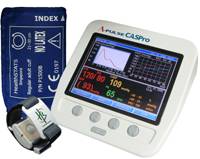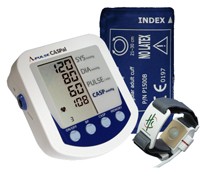Wrist-worn device to revolutionise blood pressure measurement
22 Feb 2011
A new method of measuring blood pressure by recording the pulse wave in the wrist gives a more accurate reading than the traditional arm cuff.
The new approach, invented by scientists at the University of Leicester and Singapore medical device company HealthSTATS International, accurately measures the pressure close to the heart — the central aortic systolic pressure or CASP. It has the potential to enable doctors to treat their patients more effectively.
Blood pressure is currently measured in the arm because it is convenient. However, this may not always accurately reflect what the pressure is in the larger arteries close to the heart.
In the new system, a sensor on the wrist is used to record the pulse wave and then, using computerised mathematical modelling of the pulse wave, accurately calculate the pressure close to the heart. Using this approach, central aortic systolic pressure can be measured non-invasively with an accuracy of 99%. It has been verified by comparing the pressure measured by inserting a catheter directly into the aorta close to the heart during a cardiac catheter procedure.
Patients who have tested the new device found it easier and more comfortable, as it can be worn like a watch.
Being able to measure blood pressure in the aorta which is closer to the heart and brain is important because this is where high blood pressure can cause damage. In addition, the pressure in the aorta can be quite different from that traditionally measured in the arm.
The new technology will hopefully lead to better identification of those who will most likely benefit from treatment by identifying those who have a high central aortic systolic pressure value. This will be especially important for younger people in whom the pressure measured in the arm can sometimes be quite exaggerated compared to the pressure in the aorta.
A key question is whether measurement of central aortic pressure will become routine in clinical practice. Professor Williams said: “It is not going to replace what we do overnight but it is a big advance. Further work will define whether such measurements are preferred for everybody or whether there is a more defined role in selective cases to better decide who needs treatment and who doesn’t and whether the treatment is working optimally.”
The University’s close collaboration with the Singapore-based medical device company HealthSTATS International has led to the development of this world-first technique for more accurate blood pressure measurement.
HealthSTATS has developed a range of blood pressure measurement devices that are enabled to measure central aortic systolic pressure (CASP), namely A-PULSE CASP, CASPro and CASPal, which are designed for hospital, clinical and home use respectively. All three medical devices have attained the FDA 510(k) listing and CE (MDD) Mark. For the purpose of this research, the A-PULSE CASP was used.


The CASPro (left) and CASPal (right) devices
from HealthSTATS
The research work carried out by the University of Leicester was funded by the Department of Health's National Institute for Health Research (NIHR). The NIHR has invested £3.4million with a further £2.2million capital funding from the Department of Health to establish a Biomedical Research Unit at Glenfield Hospital, Leicester, dedicated to translational research in cardiovascular research.
The work, led by Professor Bryan Williams, Professor of Medicine at the University of Leicester and consultant physician at University Hospitals of Leicester NHS Trust.
Professor Williams, who is based in the University of Leicester’s Department of Cardiovascular Sciences at Glenfield Hospital, said: “I am under no illusion about the magnitude of the change this technique will bring about. It has been a fabulous scientific adventure to get to this point and it will change the way blood pressure has been monitored for more than a century. The beauty of all of this, is that it is difficult to argue against the proposition that the pressure near to your heart and brain is likely to be more relevant to your risk of stroke and heart disease than the pressure in your arm.
“Critical to the success of this project has been the synergies of combining clinical academic work here with HealthSTATS and their outstanding medical technology platform in Singapore. This has been the game-changer and I really do think this is going to change clinical practice.”
Dr. Choon Meng Ting the Chairman and CEO of HealthSTATS said: “This study has resulted in a very significant translational impact worldwide as it will empower doctors and their patients to monitor their central aortic systolic pressure easily, even in their homes and modify the course of treatment for BP-related ailments. Pharmaceutical companies can also use CASP devices for clinical trials and drug therapy. All these will ultimately bring about more cost savings for patients, reduce the incidences of stroke and heart attacks, and save more lives.”
Professor Dame Sally Davies, Director General of Research and Development and Interim Chief Medical Officer at the Department of Health, said: “This is fantastic work by Professor Williams and his team and I am delighted to welcome these findings. I am particularly pleased that the clinical research took place at the NIHR Biomedical Research Unit in Leicester. NIHR funding for Biomedical Research Centres and Units across England supports precisely this type of translational research, aimed at pulling-through exciting scientific discoveries into benefits for patients and the NHS by contributing to improved diagnostics and treatments.”